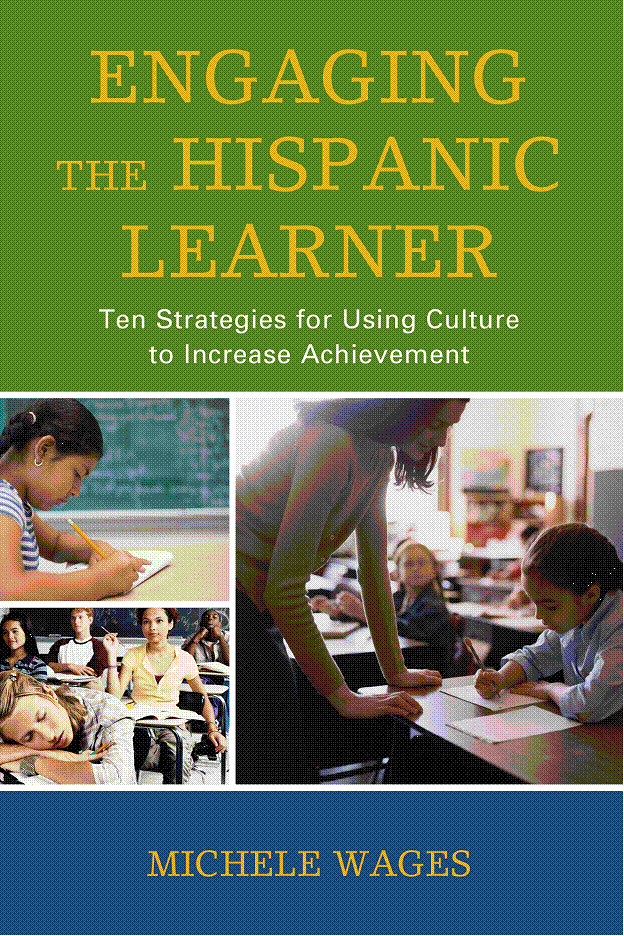
Dr.Michele Wages
Author
THE BOOK
The question in today’s schools is not which bilingual program works, but how today’s educators can use their understanding of the Hispanic culture to motivate students and increase achievement and success. “For it is not the students’ job to change their lives to make their school work better. It is up to schools to adapt to work better for students” (Jensen, 2013).

Engaging the Hispanic Learner
The ten strategies for teaching Hispanic/ELL students will undoubtedly empower teachers to reach this growing population. The easy to use format makes this book an invaluable resource.
~Cathy Mason, M.ED., fifth-grade teacher
Engaging the Hispanic Learner presents ten practical, applicable and achievable strategies that can be easily implemented in multiple content areas. The book provides the reader with a deeper understanding of the link between culture and learning needs. An interesting read!
~Karen Miller, Coordinator of Professional Development
Societal changes of late have led to a drastic increase in the number of English Language Learners in our classrooms. It is vital for teachers to be equipped with techniques and strategies to meet the needs of this ever-growing group of students. This book is an excellent resource for teachers-full of ideas, suggestions, and strategies.
Rebecca Castillo, Bilingual Educational Diagnostician

Culture, Poverty, and Education
Most changes in education including the rise of standardized testing, holding teachers accountable for their students’ academic performance, and rewriting math and reading standards—don’t address poverty. Understanding the relationship between poverty, class, and education for decades has been framed through studies on the behavior and culture of poor students and their families. Educators are caught up in the history of classism and are often guilty of buying into the mindset—including the implementation of activities and strategies for working with ‘parents’ in poverty or ‘students’ in poverty—that leads them to believe in the need to ‘fix’ the poor instead of eliminating the inequities that oppress them. So it is not just one or the other; nature or nurture, poor or not poor. Poverty is a potential outcome for all of us. Culture, Poverty, and Education: What’s Happening in Today’s Schools? is intended to not only discuss 5 myths about the culture of poverty and its effects on education but provide some resources on alternatives for educator’s to better address this growing barrier to student achievement in today’s schools.

The Achievement Gap
The achievement gap is one of the most talked about issues in U.S. education. It shows up in grades, standardized test scores, course selection, dropout rates, and college completion. This book argues that the focus on the gap is misplaced. Today, we need to look at the societal factors that have accumulated over time and have resulted in poverty level pay for teachers, lack of resources in our poorest schools and an abundance of children entering our schools unprepared. Dr. Wages has written a detailed, well-documented book that can serve as an informative resource to create an awareness of the multidimensional and complex issues of poverty.

Parent Involvement
In today’s economy, we're getting a good education has never been more important and school resources are stretched beyond points that most of us can remember, it is imperative that parents be fully engaged in their child’s education, both at home and at school. Parents play an integral role regardless of their ability to assist their children in specific subject areas or skills by encouraging their student to promote competence, control, and positive attitudes towards academics. Whether you are an educator or a parent, this book discusses barriers and methods to overcome them in order to build parental awareness while partnering with effective school communication to better become involved in the learning of their children.

Creating Culturally Responsive Classrooms
With so much cultural mixing in today’s classrooms, teachers no longer have a choice as to whether they want to interact with diversity or not. It is imperative that educators become culturally competent. By studying the cultural backgrounds of their students, teachers can learn to avoid some of the problems that surface each day in the public school classroom. Today’s classrooms are extremely diverse and many educators are not prepared for the increasing need for culturally responsive teaching. Creating Culturally Responsive Schools: One Classroom at a Time strives to help teachers discover not only what it means to be a culturally responsive educator, but also how to strengthen a schools’ staff in cultural awareness, respect, and value and how to use this knowledge to increase all student achievement. Each chapter is self-sufficient allowing the reader to utilize only those parts of the book needed. This is an invaluable educational resource addressing current classroom demographics.